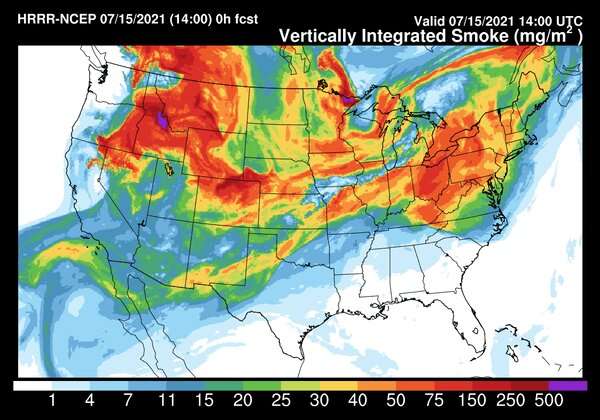What's in wildfire smoke? A toxicologist explains its dangerous components

Something unusual happened this year in Idaho. Fire and health officials about the health risks of wildfire smoke several weeks earlier than normal. With , it was only a matter of time before the risks became reality.
Smoke is now graying the sky as , and a lot of people are wondering what's in the air they're breathing.
As an , I am interested in understanding wildfire smoke effects and how they from other sources of air pollution. We know that breathing wildfire smoke can be harmful. It's not totally clear what the worsening wildfire landscape will mean for public health, but research is raising red flags.
In parts of the West, wildfire smoke now makes up measured annually. A new by the California Air Resources Board found another threat: high levels of lead and other metals turned up in smoke from the 2018 Camp Fire, which destroyed the town of Paradise. The findings suggest smoke from fires that reach communities could be even more dangerous than originally thought because of the building materials that burn.
With already burning, here's a closer look at what makes up wildfire smoke and what you can do to protect yourself and your family.
What's in wildfire smoke?
depends on a few key things: what's burning—grass, brush or trees; the temperature—is it flaming or just smoldering; and the distance between the person breathing the smoke and the fire producing it.
The distance affects the ability of smoke to "age," meaning to be acted upon by the Sun and other chemicals in the air as it travels. . Importantly, large particles like what most people think of as ash do not typically travel that far from the fire, but small particles, or aerosols, can travel .
Smoke from wildfires contains , including carbon monoxide, volatile organic compounds, carbon dioxide, hydrocarbons and nitrogen oxides. The most prevalent pollutant by mass is particulate matter less than 2.5 micrometers in diameter, roughly 50 times smaller than a grain of sand. Its prevalence is one reason health authorities issue air quality warnings using PM2.5 as the metric.
The new study on smoke from the 2018 Camp Fire found in smoke blowing downwind as the fire burned through Paradise, California. The metals, which have been linked to high blood pressure and developmental effects in children with long-term exposure, traveled more than 150 miles on the wind, with concentrations 50 times above average in some areas.
What does that smoke do to human bodies?
There is another reason : It defines the cutoff for particles that can travel deep into the lungs and cause the most damage.
The human body is equipped with natural defense mechanisms against particles bigger than PM2.5. As I tell my students, if you have ever or blown your nose after being around a campfire and discovered black or brown mucus in the tissue, you have witnessed these mechanisms firsthand.
The really small particles bypass these defenses and disturb the air sacs where oxygen crosses over into the blood. Fortunately, we have specialized immune cells present called macrophages. It's their job to seek out foreign material and remove or destroy it. However, that repeated exposure to elevated levels of wood smoke can suppress macrophages, leading to increases in lung inflammation.
The record wildfire season out west (yes, made worse by climate change) is having an impact here. Haze overhead is wildfire smoke that traveled over 1,000 miles and will continue at least through this evening.
— James Gilbert (@JamesGilbertWX)
Dose, frequency and duration are important when it comes to smoke exposure. Short-term exposure can irritate the eyes and throat. Long-term exposure to wildfire smoke over days or weeks, or breathing in heavy smoke, can raise the risk of and may also contribute to . Considering that it is the macrophage's job to remove foreign material—including smoke particles and pathogens—it is reasonable to make a between smoke exposure and risk of viral infection.
Recent evidence suggests that long-term exposure to PM2.5 may make the coronavirus more deadly. A nationwide study found that even a small increase in PM2.5 from one U.S. county to the next was associated with a from COVID-19.
What can you do to stay healthy?
Here's the advice I would give just about anyone downwind from a wildfire.
Stay informed about air quality by identifying local resources for air quality alerts, information about active fires and recommendations for better health practices.
If possible, avoid being outside or doing strenuous activity, like running or cycling, when there is an air quality warning for your area.
Be aware that not all face masks protect against smoke particles. Most cloth masks will not capture small wood smoke particles. That requires an N95 mask in conjunction with fit testing for the mask and training in how to wear it. Without a proper fit, N95s do not work as well.
Establish a clean space. Some communities in western states have offered "clean spaces" programs that help people take refuge in buildings with clean air and air conditioning. However, during the pandemic, being in an enclosed space with others can create other health risks. At home, a person can create clean and cool spaces using a window air conditioner and a .
people to avoid anything that contributes to indoor air pollutants. That includes vacuuming that can stir up pollutants, as well as burning candles, firing up gas stoves and smoking.
Provided by The Conversation
This article is republished from under a Creative Commons license. Read the .![]()

















